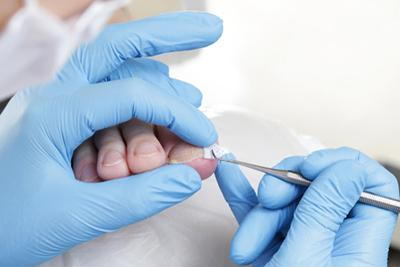What To Do About Ingrown Toenails

- posted: Apr. 28, 2024
Receive expert treatment for your ingrown toenails in Boise, Nampa, and Meridian, ID, by consulting Dr. Ryan Kemp, Dr. Kerry Anderson, and Dr. Boyd Andrews of Idaho Foot & Ankle Associates.
What Are Ingrown Toenails?
Properly trimming your toenails is not only an important habit to develop for personal hygiene. It’s also a habit that can help you avoid developing ingrown toenails and foot pain.
Ingrown toenails form when the sides of your toenails burrow into your skin instead of growing forward. Your toenails may grow in that direction because you trimmed them too short or tapered their edges. Stubbing your toe or dropping something on it can also change the growth path of your toenail, thus causing it to become ingrown.
The shoes you wear can also cause ingrown toenails. Tight shoes that cause your toes to bunch together are notorious for creating the aforementioned problem.
Certain risk factors can also make a person more susceptible to ingrown toenails. Those include having naturally curved toenails and sweaty feet.
Foot pain is not the only thing you must worry about once your toenails are ingrown. Your swollen toes can make it harder for you to walk or wear shoes. Ingrown toenails can also lead to infections.
Don’t allow ingrown toenails to jeopardize your health and comfort. Dr. Kemp, Dr. Anderson, and Dr. Andrews of Idaho Foot & Ankle Associates can offer expert treatment for ingrown toenails in Boise, Nampa, and Meridian, ID.
How Can You Address the Problems Caused by Your Ingrown Toenails?
What should you do if you have an ingrown toenail?
First, you should develop a habit of soaking your feet in warm water. Soak your feet multiple times daily. Once you’re done, dry your feet thoroughly and prevent them from getting wet until your next soak.
You can also place a cotton strand underneath the toenail to push your skin away from your ingrown toenails. Continue doing that until your toenails grow in the right direction.
If those home remedies haven’t addressed the issue, you should start making plans with a podiatrist. Seeking expert treatment is also necessary if your ingrown toenails have become infected.
A podiatrist can treat your ingrown toenails and infections with antibiotics. In some cases, the podiatrist may lift the toenail to prevent it from reaching deeper into your skin. Partially removing the toenail may also be considered.
Partner with Dr. Kemp, Dr. Anderson, and Dr. Andrews of Idaho Foot & Ankle Associates if you need treatment for ingrown toenails. Call 208-327-0627 for our Boise clinic, 208-463-1660 for our Nampa location, or 208-888-9876 for our office in Meridian, ID.

- posted: Apr. 28, 2024
Receive expert treatment for your ingrown toenails in Boise, Nampa, and Meridian, ID, by consulting Dr. Ryan Kemp, Dr. Kerry Anderson, and Dr. Boyd Andrews of Idaho Foot & Ankle Associates.
What Are Ingrown Toenails?
Properly trimming your toenails is not only an important habit to develop for personal hygiene. It’s also a habit that can help you avoid developing ingrown toenails and foot pain.
Ingrown toenails form when the sides of your toenails burrow into your skin instead of growing forward. Your toenails may grow in that direction because you trimmed them too short or tapered their edges. Stubbing your toe or dropping something on it can also change the growth path of your toenail, thus causing it to become ingrown.
The shoes you wear can also cause ingrown toenails. Tight shoes that cause your toes to bunch together are notorious for creating the aforementioned problem.
Certain risk factors can also make a person more susceptible to ingrown toenails. Those include having naturally curved toenails and sweaty feet.
Foot pain is not the only thing you must worry about once your toenails are ingrown. Your swollen toes can make it harder for you to walk or wear shoes. Ingrown toenails can also lead to infections.
Don’t allow ingrown toenails to jeopardize your health and comfort. Dr. Kemp, Dr. Anderson, and Dr. Andrews of Idaho Foot & Ankle Associates can offer expert treatment for ingrown toenails in Boise, Nampa, and Meridian, ID.
How Can You Address the Problems Caused by Your Ingrown Toenails?
What should you do if you have an ingrown toenail?
First, you should develop a habit of soaking your feet in warm water. Soak your feet multiple times daily. Once you’re done, dry your feet thoroughly and prevent them from getting wet until your next soak.
You can also place a cotton strand underneath the toenail to push your skin away from your ingrown toenails. Continue doing that until your toenails grow in the right direction.
If those home remedies haven’t addressed the issue, you should start making plans with a podiatrist. Seeking expert treatment is also necessary if your ingrown toenails have become infected.
A podiatrist can treat your ingrown toenails and infections with antibiotics. In some cases, the podiatrist may lift the toenail to prevent it from reaching deeper into your skin. Partially removing the toenail may also be considered.
Partner with Dr. Kemp, Dr. Anderson, and Dr. Andrews of Idaho Foot & Ankle Associates if you need treatment for ingrown toenails. Call 208-327-0627 for our Boise clinic, 208-463-1660 for our Nampa location, or 208-888-9876 for our office in Meridian, ID.
